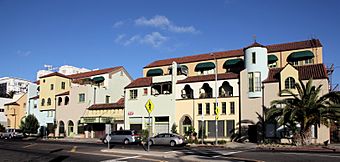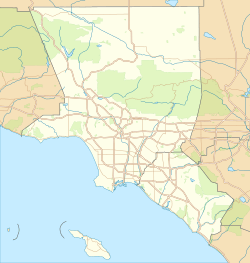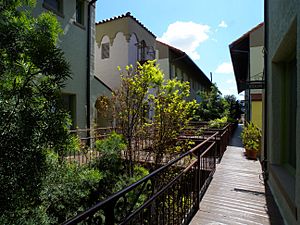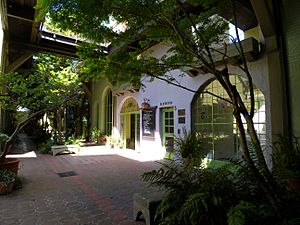Granada Shoppes and Studios facts for kids
|
Granada Shoppes and Studios
|
|
 |
|
| Location | 672 S. Lafayette Park Place, Westlake District, Los Angeles, California |
|---|---|
| Built | 1927 |
| Architect | Franklin Harper |
| Architectural style | Mediterranean Revival, Spanish Colonial Revival |
| NRHP reference No. | 86003320 |
Quick facts for kids Significant dates |
|
| Added to NRHP | November 20, 1986 |
The Granada Shoppes and Studios, also known as the Granada Buildings, is a unique and beautiful group of buildings in Central Los Angeles, California. It's designed in the Mediterranean Revival and Spanish Colonial Revival styles. This block-long complex has four buildings connected by a lovely courtyard.
It was built in 1927, right next to Lafayette Park in the Westlake District.
Building History
The Granada Buildings were designed by an architect named Franklin Harper. His plan, announced in 1927, included 42 special units. These units were unique because they combined offices or shops with living spaces.
Each unit had two levels. The first floor was for offices or shops. The second floor, or loft area, was for living. The Los Angeles Times newspaper called this $1 million building "something entirely new" for Los Angeles. It reminded people of charming specialty shops found in Europe. The living areas on the mezzanine (middle) level had a kitchen, living room, bathroom, and an open porch.
Cool Design Features
The most important part of the Granada Buildings is the courtyard. This open space runs between all four buildings. It helps people get to each unit. It also acts like a beautiful garden, offering shade and a peaceful place to relax.
One architecture book said the outdoor space is the main idea behind the building. It makes the complex feel like a "traditional narrow commercial street."
The Granada's beauty has always attracted creative people. Architects like Gregory Ain and James Garrott had offices here before World War II. George Hurrell, a famous Hollywood photographer, lived and worked in Suite 9. He took pictures of silent film stars right there at the Granada.
A book called "Courtyard Housing" described the Granada like this:
The Granada Buildings are almost legendary in the Los Angeles design world. Many architects, graphic designers, and artists have made them their homes. The courtyard is one of the most important places in southern California architecture. It shows how city life could have been, a promise that was never fully met.
Saving the Granada Buildings
In 1980, a famous writer for the Los Angeles Times, Jack Smith, called it "the lovely old Spanish-style Granada Building." Later, it was officially renamed the Granada Buildings.
In the late 1980s, a group called the Shidler Group bought and fixed up the complex. They even won an award from the Los Angeles Conservancy for their work. In 2003, LA Weekly magazine named the Granada the "Best Nonprofit Enclave." This was because many non-profit groups had their offices there. These included PEN Center USA, Theatre of Hearts, and People in Progress.
LA Weekly said that creative people love the Granada because of its interesting past and charming design. They also liked its old-fashioned elevator and the beautiful courtyard. The courtyard has a lovely garden with fountains. It feels like a little piece of the Alhambra (a famous palace in Spain) close to MacArthur Park.
The Granada complex was named a Historic Cultural Monument (number 238) by the Los Angeles Cultural Heritage Commission in April 1981. It was also added to the National Register of Historic Places in 1986. This means it's a very important historical site.
The Granada is one of several historic places around Lafayette Park. Others include the Bryson Apartment Hotel, The Town House, the Felipe De Neve Branch library, and Bullocks Wilshire.






